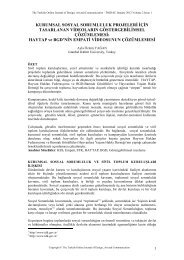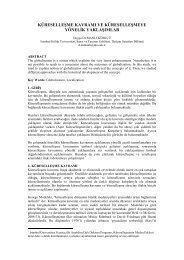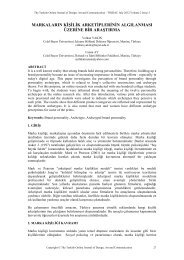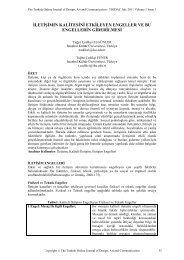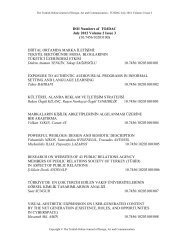aprıl 2012 - tojdac.org
aprıl 2012 - tojdac.org
aprıl 2012 - tojdac.org
Create successful ePaper yourself
Turn your PDF publications into a flip-book with our unique Google optimized e-Paper software.
The Turkish Online Journal of Design, Art and Communication - TOJDAC April <strong>2012</strong> Volume 2 Issue 2<br />
Stricto sensu, a three-dimensional film or stereoscopic 3D film is a motion picture that enhances<br />
the illusion of depth perception. Derived from stereoscopic photography, a regular motion picture<br />
camera system is used to record the images as seen from two perspectives, and special projection<br />
hardware and/or eyewear are used to provide the illusion of depth when viewing the film. 3-D<br />
films are not limited to feature film theatrical releases; television broadcasts and direct-tovideo<br />
films have also incorporated similar methods, primarily for marketing purposes, or for what<br />
we will define in the next chapter as an “adaptive unconscious” of an audience.<br />
The perceptions are still different. James Cameron, while he's not the first to embrace the<br />
technology, he has become its most vocal evangelist, asserting that digital 3-D is now good<br />
enough to make it-after sound and color--the third sea change to affect movies affirms: "This<br />
really is a revolution". Director Christopher Nolan, instead, doesn’t separate very much the<br />
techniques, he unifies them: “I think it’s a misnomer to call it 3-D versus 2-D. The whole point of<br />
cinematic imagery is it’s three-dimensional…95% of our depth cuescome from occlusion,<br />
resolution, color and so forth, so the idea of calling a 2-D movie a “2-D movie” is a little<br />
misleading...”<br />
1.2. The Chronology Of The 3-D Ars Combinatoria<br />
The history of the 3-d technique is one of the most intricate in the history of cinema.<br />
• In 1894 William Friese Greene files a patent application for a 3D viewing process using<br />
two screens side by side, united in the viewer's eye by a cumbersome stereoscope<br />
headset. As with all his endeavors, he is ahead of his audience by about 30 years.<br />
• In 1915 the first presentation of 3D films before a paying audience took place at the Astor<br />
Theater, New York. The program consisted of three one-reels, the first of rural scenes in<br />
the USA, the second a selection of scenes from Famous Players' Jim, the Penman (US<br />
'15), with John Mason and Marie Doro, and the third the Niagara Falls. The anaglyphic<br />
process used, developed by Edwin S. Porter and W.E. Waddell, involved the use of red<br />
and green spectacles to create a single image from twin motion picture images<br />
photographed 2! inches apart. The experiment was not a success. Lynde Denig wrote<br />
in Moving Picture World: "Images shimmered like reflections on a lake and in its present<br />
form the method couldn't be commercial because it detracts from the plot."<br />
• In 1922, premiered the first 3D feature film, Nat Deverich's 5-reel melodrama Power of<br />
Love, starring Terry O'Neil and Barbara Bedford, at the Ambassador Hotel Theater, Los<br />
Angeles. The film related the adventures of a young sea captain in California.<br />
• In 1936 was released the first feature-length talkie in 3D, Sante Bonaldo's Nozze<br />
vagabonde (Italy), starring Leda Gloria and Ermes Zacconi, which was produced by the<br />
Società Italiana Stereocinematografica at the Cinee-Caesar Studios.<br />
• In 1947, the first feature-length talkie in color and 3D was Alexander Andreyevsky's<br />
Soyuzdet film production Robinson Crusoe (USSR). The process used, Stereokino, was<br />
the first to successfully dispense with anaglyphic spectacles. The most difficult technical<br />
problem encountered during the production of Robinson Crusoe was persuading a wild<br />
cat to walk along a thin branch towards the camera. After five nights occupied with this<br />
one scene, the cameraman succeeded in getting a satisfactory shot. The effect, according<br />
to accounts, was riveting, the animal seeming to walk over the heads of the audience and<br />
disappear at the far end of the cinema.<br />
• In 1953 is created the first 3D feature with stereophonic sound, Andre de Toth' House of<br />
Wax (US). When it was premiered at the Paramount Theater, New York, with 25<br />
speakers, the Christian Science Monitor was moved to deplore the "cacophony of sound<br />
hurtling relentlessly at one from all directions".<br />
Copyright © The Turkish Online Journal of Design, Art and Communication 56




